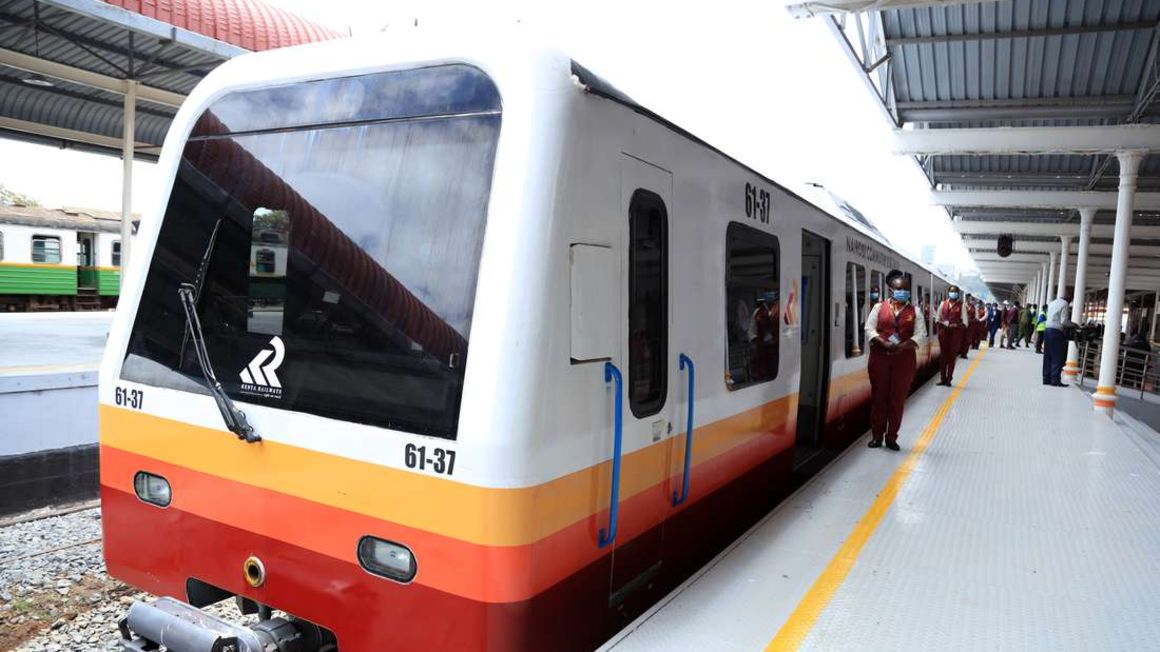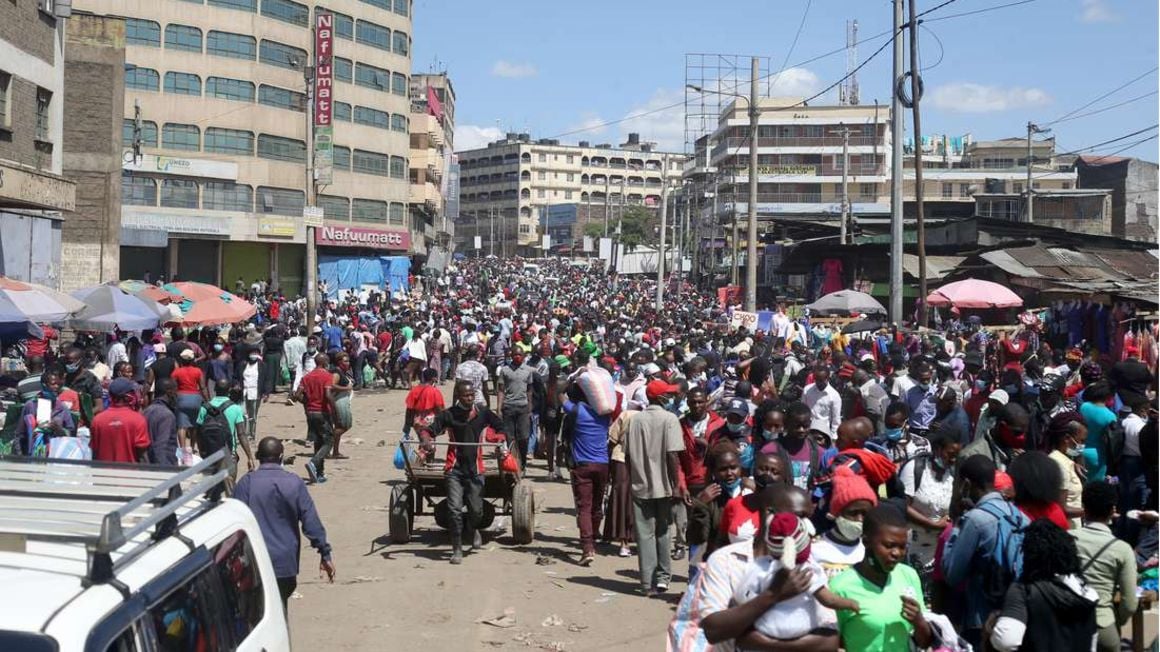
Hostesses wait to usher in commuters to the newly commissioned diesel trains at the Nairobi Central Railway Station on November 10, 2020. PHOTO | JEFF ANGOTE | NMG
Summary
- NMS director for roads and transport, Michael Ochieng, says the strategy to decongest the capital city seeks to tap into the MRT that will incorporate a multi-pronged approach.
- The first phase of the project, which is part of the Nairobi Urban Mobility Plan, follows Nairobi River from Doonholm to Westlands through Eastlands so that people can walk or cycle into CBD, Industrial Area and Westlands.
- The second phase joins Phase One at the CBD and goes to Lang’ata via railway city while phase three is from CBD to Roysambu through Ngara.
The Nairobi Metropolitan Services (NMS) is banking on non-motorised transport and bus rapid transit (BRT) as last-mile connectors in its bid to decongest Nairobi central business district (CBD).
The strategy is part of the planned implementation of mass rapid transport (MRT), including commuter rail service, non-motorised transport and BRT corridors to solve perennial congestion in the capital city.
In September, NMS director-general Mohammed Badi announced that public service vehicles (PSVs) would be relocated from the city centre to termini outside the CBD before the end of the year.
According to the plan, matatus plying Ngong and Lang’ata roads will terminate their journey at the Green Park Bus Terminus, popularly known as Railways Club.
Long-distance PSVs from Mount Kenya region and those from the Thika Superhighway, which have been terminating at Tea Room on Accra Road, would drop and pick passengers at Desai and Park Road termini in Ngara.
On the other hand, Muthurwa terminus is expected to remain and serve PSVs from Jogoo and Lusaka roads.
Matatus from Mombasa Road will terminate at a new terminus to be constructed at the junction of Bunyala and Workshop Road while PSVs using the Waiyaki Way, Uhuru Highway, Kipande and Limuru roads will end their journey at the Fig Tree terminus in Ngara.
NMS director for roads and transport, Michael Ochieng, says the strategy to decongest the capital city seeks to tap into the MRT that will incorporate a multi-pronged approach.
Already, the implementation of non-motorised transport corridors in the city centre has kicked off with Kenyatta Avenue, Wabera and Muindi Mbingu streets having pedestrian and cycle paths.
He said the non-motorised transport would offer safe walking and cycling space for residents who would want to walk from the termini outside the city centre as they will be linked to the termini.
Kenyatta Avenue non-motorised transport will be connected to the new Ngong Road, which already has the same corridor. The other side of Kenyatta Avenue will be linked to Moi Avenue, which will further connect to Railway Station where construction of both cycle and footpaths is already at the roundabout of Haile Selassie and Moi Avenue.
On Haile Selassie Avenue, the non-motorised transport will connect to Jogoo Road through Landhies Road. Jogoo Road already has non-motorised transport that terminates at the roundabout near City Stadium.
For the termini in Ngara, already construction of a non-motorised transport from Fig Tree to connecting the termini to Race Course road then to the city centre has begun.
“The new cycling and footpaths are being provided to link those termini to the CBD. If you go to Green Park, it will be linked with the paths covered with a shade through Uhuru Highway into town,” said Mr Ochieng.
“So it will be one’s choice if they want to take a bus again or just walk to town. And I can tell you that most Nairobi residents will prefer to walk as these are short distances. In developed cities, people walk even over longer distances. I know people will prefer to walk on the footpaths rather than squeeze in matatus to town where they will take another 30 minutes in a traffic jam,” he added.

Shoppers at Kamukunji market in Nairobi on November 15, 2020. PHOTO | SILA KIPLAGAT | NMG
The first phase of the project, which is part of the Nairobi Urban Mobility Plan, follows Nairobi River from Doonholm to Westlands through Eastlands so that people can walk or cycle into CBD, Industrial Area and Westlands.
The second phase joins Phase One at the CBD and goes to Lang’ata via railway city while phase three is from CBD to Roysambu through Ngara.
The next strategy will involve incorporation of BRT buses which will be ferrying commuters across the city centre.
Mr Ochieng says already an elaborate intra-city park-and-ride commuter rail service has been rolled out targeting the populous Eastlands with BRT buses provided to offer intermediate link.
The buses, he says, will be given special passes to access the city centre on scheduled times linked to the commuter rail timetable.
Mr Ochieng says the long-range BRT buses will be terminating at the railway stations but will have to pick up and drop off points in strategic places including specific commuter stages such as at Kencom, GPO and Hurlingham, among others.
For example, there will be a BRT connecting Fig Tree terminus to Kencom then another one from Kencom to Green Park.
“We have already begun the journey to the final BRT. The buses will be the intermediate link, which will help those who choose to use them from the termini to the city centre. This will be used by those who do not want to walk, including the physically challenged, expectant women and the sick,” said Mr Ochieng.
“The city rail system buses will ply over 10 routes through the city where commuters on the train can board the buses at Central Rail Stations and other designated stops within the routes.
“The NMT corridors in place, stretching into the CBD from the termini to the estates, include cycle and walkways further offering options to access the city on foot or a bike,” he added.
For the BRT, Nairobi Metropolitan Area Authority has gazetted 12 mobility corridors, seven of them for core mass rapid transportation linking Limuru, Ngong Town, Kenol, Murang’a, Kiambu, Ruai, Jomo Kenyatta International Airport (JKIA) and Konza techno city.
The remaining five comprise rapid transport corridors along Line 2, which have been contracted and works on them will begin soon.
Line 1 is to run from James Gichuru Road/Waiyaki Way to JKIA — a distance of 20 kilometres, while Line 2, which is 31 kilometres long, will run from Lang’ata Road to Ngong Road as well as Juja Road and Komarock Road to Ruiru. It will have major stops at Dandora, Kariobangi and near Gikomba Market.
Line 3 will run from Githurai through Thika Road to Moi Avenue in the CBD and terminate at Kenyatta National Hospital. Line 4 will cover 14km from T-Mall to Jogoo Road while Line 5 will cover Outer Ring Road.
The BRT buses, with a capacity of 160 passengers will ferry passengers from railway stations to the city and vice-versa and also along the select road corridors. The commuters will use electronic cards for payment at the stations.
The project will comprise more than 100 buses operating on dedicated lanes on the Thika Superhighway, through the city centre to Kenyatta National Hospital (KNH).
For more efficiency, Kenya Railway Corporation (KRC) has also launched the commuter rail service, which will eventually link to the BRT and also along the select road corridors.
The newly-launched commuter rail service operating on a park-and-ride model will be originating from Nairobi Central station to Ruiru via Dandora, Githurai and Kahawa, to Syokimau via Makadara and Imara Daima, Embakasi village via Pipeline and Donholm and Kikuyu via Kibera and Dagoretti.
In February, the KRC said the government would purchase 11 diesel multiple units (DMUs) during the year for Sh1.15 billion. The new DMUs expected to ply five routes from Nairobi Central Station to Embakasi Village, Syokimau, Kitengela, Kikuyu and Thika.
Ongoing debate
The five routes will later be joined by nine new stations, which are in the process of being built, including in Umoja, Kibera, Thika, Mbagathi Way, Kenyatta and Strathmore universities, Kitengela and Thogoto.
Meanwhile, Mr Ochieng says, boda boda will also be catered for in the designated termini in terms of where they will park, pick and drop passengers heading to other destinations.
“They give good service, but the sector has to be regulated as we cannot have a city full of boda boda everywhere. The debate is going on with them,” he said.
The termini will not act as a parking slot. They will operate solely as pick-and-drop points with a timed schedule where a matatu will take only five minutes to drop off and then another five to pick passengers. They will use the concept of an airport.
In the long term, Mr Ochirng says the plan will be to discourage personal vehicles getting into the CBD as well as taxis as the improvement in the public transport would see most people prefer to leave their vehicles at home.
“There are plans to use existing termini within the city centre, which will not be used in the ongoing plans, for economic and social value. For instance, some can be turned into green spaces to make them amenable and enjoyable to the residents,” he says.





No comments :
Post a Comment